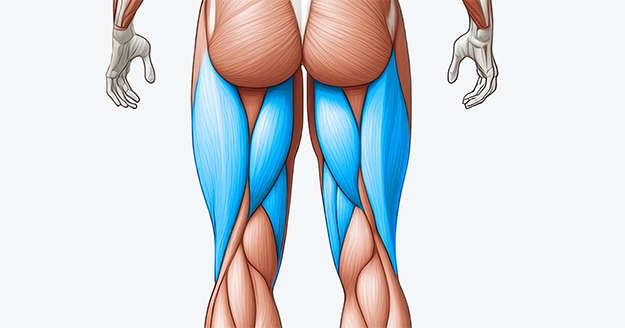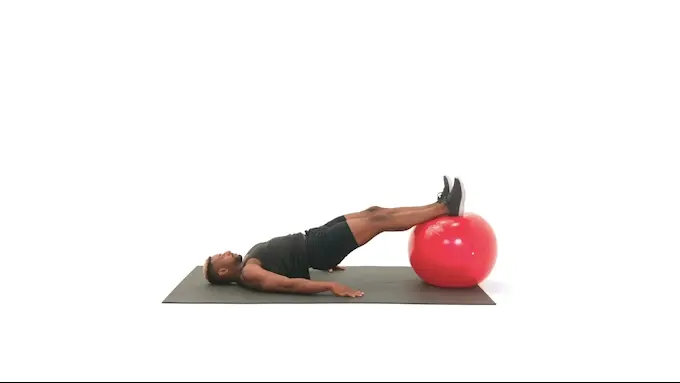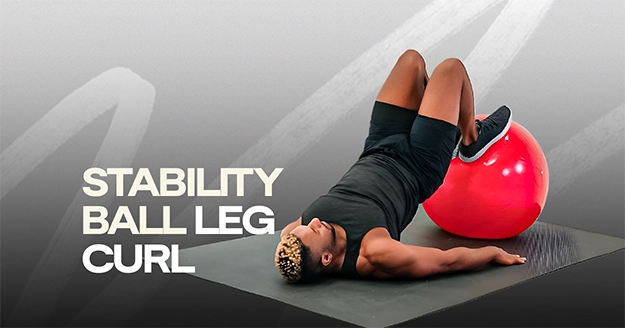Exercise Profile
Stability Ball Leg Curl Overview
The Stability Ball Leg Curl is a highly effective lower body exercise that mainly focuses on the hamstrings while activating the glutes and core for stabilization. It is a versatile addition to various workout routines.
This exercise helps beginners develop hamstring strength with minimal strain on the lower back. More advanced users can increase the challenge by utilizing a single-leg variation to enhance intensity and muscle engagement.
Leg Curl Stability Ball can be used in your leg workouts to target the hamstrings or included in full-body workouts for overall lower-body development. They are also ideal for warm-ups to improve muscle activation and mobility in the lower body.

Stability Ball Leg Curl Instructions
Step 1: Lay flat on the floor, your feet on the stability ball. Your heels should be centered on top of the ball, with your knees slightly bent.
Step 2: Lift your hips into a glute bridge and hold this position throughout the exercise.
Step 3: Press your heels into the ball to engage your hamstrings, then pull the ball toward you by bending your knees and bringing your heels to your glutes.
Step 4: Inhale and slowly reverse the movement while keeping tension in your hamstrings and glutes.

Common Stability Ball Leg Curl Variations
Leg Curl on stability ball is a great way to strengthen your hamstrings, but you can modify the exercise to adjust the difficulty or target different regions of this muscle. Here are some common variations to try in your routine:
Stability Ball Leg Curl Tips
- Ensure your heels are centered on the stability ball with your knees slightly bent. This helps maintain balance and control throughout the exercise.
- Drive your hips upward into a glute bridge and hold this position. Keeping your hips elevated is crucial for engaging your hamstrings and glutes effectively.
- Inhale as you reverse the movement, maintaining tension in your hamstrings and glutes. This engages your hamstrings and allows for a more effective contraction.
- Controlled breathing enhances stability and control throughout the exercise.
- Maintain a flat back and avoid overarching your lower back during the curls. Keeping a neutral spine helps prevent injury and ensures the correct muscles are engaged.
Stability Ball Leg Curl Common Mistakes
- Not Keeping the Glutes Elevated: It decreases hamstring and glute engagement, making the exercise less effective and raising the risk of lower back strain.
- Poor Foot Placement: Setting your feet too far forward or back on the ball can limit the range of motion of the movement.
- Using Momentum: Relying on momentum rather than controlled movement can compromise form and lead to insufficient muscle activation, reducing the exercise’s benefits.
Frequently Asked Questions
How often should I perform Stability ball leg curl exercise?
The frequency of Stability ball hamstring curls varies by fitness level. Beginners should aim for one to two sessions each week on non-consecutive days, while more experienced individuals can aim for three to four sessions weekly.
Are stability ball hamstring curls effective?
Stability ball hamstring curls effectively strengthen the hamstrings, glutes, and core. The ball’s instability increases muscle activation and enhances overall lower-body stability.
What is the function of a stability ball?
Stability balls enhance balance, muscle tone, and core stability.
Are stability balls beneficial for your back?
Stability balls enhance posture and core engagement, potentially alleviating back pain.
Is the stability ball effective for working the abs?
The stability ball effectively targets the abs by enhancing core engagement and stability during exercises.
Post your post-workout selfies in IG and tag @trainestapp, #trainest, or DM them to us to get a shoutout on Trainest Stories!



